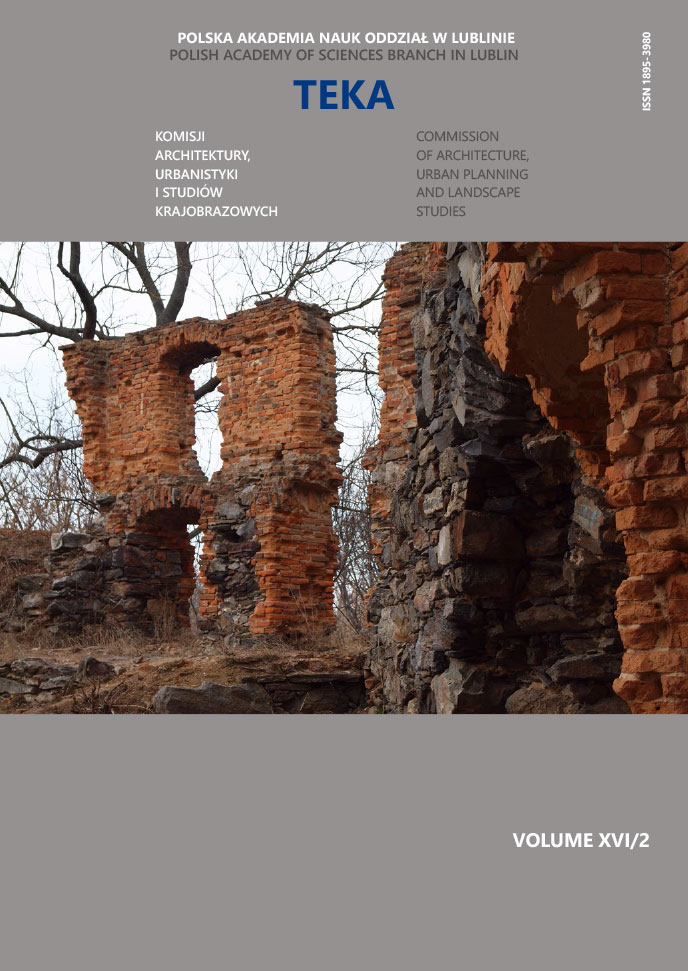Revitalization of the city’s riverside areas on the example of the urstromtal of the Malczewski Stream in Radom
Article Sidebar
Open full text
Issue Vol. 16 No. 2 (2020)
-
Perception and functionality of space in view of potential and dysfunction of senses
Sense-sensitive Architectural DesignAgata Gawlak, Magda Matuszewska, Agnieszka Ptak, Magdalena Priefer7-16 -
Nineteenth-century, non-existent buildings of the Castle Hill in Lublin
Krzysztof Janus17-25
-
Freehand drawing as a basic means of artistic expression in the process of educating future architects versus modern computer technology
Agnieszka Chęć-Małyszek26-36
-
The image of the spa town of Szczawno-Zdrój in light of the transformation of the city of Wałbrzych at the turn of the 20th and 21st centuries
Marek Piróg37-43
-
Contemporary architectural interventions in the historical tissue of Cádiz – contextual minimalism in the service of genius loci
Joanna Białkiewicz44-56
-
The Community House (Dom Ludowy) in Nałęczów as an example of social architecture of the early 20th century
Kamila Lucyna Boguszewska57-67
-
Architecture and typhlology. The potential of scientific partnership
Agnieszka Kłopotowska68-75
-
Use of laminated timber in the construction of high-rise buildings, on the example of implementations from western countries
Michał Dmitruk76-87
-
Zbór kalwiński w Piaskach – od ruiny do trwałej ruiny
Piotr Gleń88-93
-
Artistic painted decorations on the outside walls of the castles in western Ukraine
Mykola Bevz94-106
-
Revitalization of the city’s riverside areas on the example of the urstromtal of the Malczewski Stream in Radom
Margot Dudkiewicz, Marek Dąbski, Sylwester Kaczmarski107-112
Archives
-
Vol. 18 No. 4
2022-12-30 5
-
Vol. 18 No. 3
2022-12-27 5
-
Vol. 18 No. 2
2022-12-27 5
-
Vol. 18 No. 1
2022-12-27 4
-
Vol. 17 No. 4
2021-12-30 11
-
Vol. 17 No. 3
2021-12-30 9
-
Vol. 17 No. 2
2021-12-30 8
-
Vol. 17 No. 1
2021-12-30 8
-
Vol. 16 No. 4
2020-12-30 11
-
Vol. 16 No. 3
2020-09-30 10
-
Vol. 16 No. 2
2020-06-30 11
-
Vol. 16 No. 1
2020-03-31 10
-
Vol. 15 No. 4
2019-12-30 6
-
Vol. 15 No. 3
2019-10-31 9
-
Vol. 15 No. 2
2019-06-28 12
-
Vol. 15 No. 1
2019-03-29 13
-
Vol. 14 No. 3
2018-10-28 14
-
Vol. 14 No. 2
2018-06-29 14
-
Vol. 14 No. 1
2018-03-30 13
Main Article Content
DOI
Authors
Abstract
The area of the primeval valley of the Malczewski stream, located on the border of two blocks of flats inside the Radom housing estate Południe, has remained undeveloped for over twenty years. The existing stand is mainly self-seeding with the dominance of Salix alba (32%) and Populus tremula (16%). In addition, there are: Alnus incana (11%), Quercus rubra (10%), Acer negundo (7%) and others. There are no paved pedestrian routes. The conceptual design of the new development of the valley is a response to the needs of local residents. The project involves the creation of a square in the middle of the plot, with a focal point in the form of a fountain. Provides for the separation of an area with sports and recreational functions with a fitness and skate park, as well as two playgrounds for children. There is also a designated area for a dog paddock. A part of the park with a roofed gazebo and three paved squares with stone barbecues will serve as a recreation and leisure function for entire families. Referring to the names of the surrounding housing estate Południe and associations with the sun - the place was given the name of Sunny Park. The name of the park is underlined by the arrangement of alleys, reflecting the journey of the sun in the sky.
Keywords:
References
Bernat S. 2010. Doliny rzeczne i ich percepcja, Krajobrazy kulturowe dolin rzecznych, potencja i wykorzystanie. Prace Komisji Krajobrazu Kulturowego PTG 7: 167−178.
Borcz Z. 2000. Elementy projektowania zieleni. Wyd. Akademii Rolniczej we Wrocławiu, Wrocław.
Domańska J. 2012. Przyszłość dolin rzecznych w miastach. Czasopismo Techniczne sekcja Architektura 1: 131−139.
Majdecki L. 2009. Historia ogrodów, Wyd. PWN, Warszawa.
Malczyk T. 2005. Wytyczne do projektowania zieleni na terenach zabudowanych, Nysa.
Nowakowski M. 1990. Centrum miasta. Wyd. Arkady Warszawa.
Oleksiejuk E. 2005. Rola i funkcje zieleni w mieście [w:] Oleksiejuk E., Piotrowiak J. (red.), Zieleń miejska. Naturalne bogactwo miasta. Zasady gospodarowania i ochrona. Materiały konferencyjne, Wyd. Polskie Zrzeszenie Inżynierów i Techników Sanitarnych Oddział Toruń, Toruń: 111−117.
Pancewicz A. 2004. Rzeka w krajobrazie miasta, Wydawnictwo Politechniki Śląskiej, Gliwice.
Tołwiński T. 1963. Urbanistyka. Tom III Zieleń w urbanistyce, Państwowe Wydawnictwo Naukowe, Warszawa.
Seneta W., Dolatowski J. 2012. Dendrologia. Wydawnictwo Naukowe PWN, Warszawa.
Zachariasz A. 2012. Parki przyszłości – o różnych koncepcjach kształtowania terenów zieleni w miastach. Czasopismo Techniczne Architektura z. 1-A2: 455−462.
Article Details
Abstract views: 206
License

This work is licensed under a Creative Commons Attribution-ShareAlike 4.0 International License.


